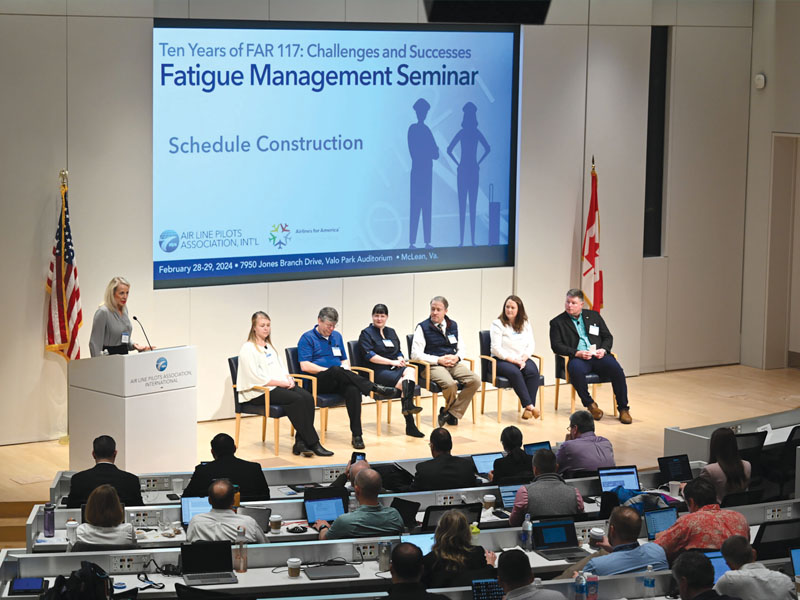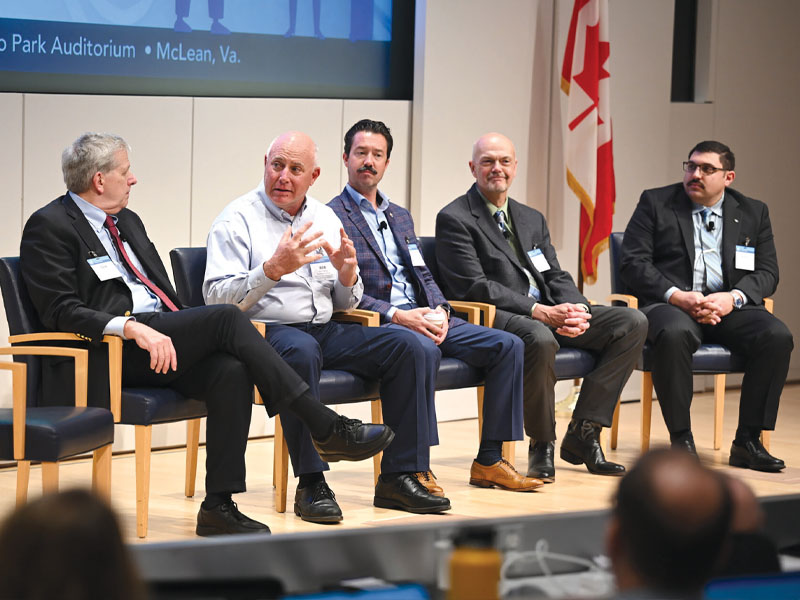A Decade of FAR Part 117
Pilots Discuss Challenges and Successes Since Implementation
By Gavin Francis, Senior Aviation Writer

Capt. Lisa Nydahl (Delta) moderates a panel on schedule construction during the Fatigue Management Seminar.
Pilots gathered at ALPA’s headquarters in McLean, Va., on February 28–29 to take part in the two-day Fatigue Management Seminar. The annual conference, organized by ALPA in partnership with Airlines for America, brings together pilots, government and industry representatives, safety advocates, and researchers to discuss ways to mitigate the risks posed by pilot fatigue. Capt. Doug Marchese (JetBlue), ALPA’s Flight Time/Duty Time Committee chair, emceed this year’s seminar, which looked at FAR Part 117 and its impact on reducing pilot fatigue since it went into effect a decade ago. More than 100 individuals attended the seminar with 25 pilot groups represented.
FAR Part 117 was implemented by the FAA in 2014 to establish flight and duty limitations and rest requirements for pilots operating passenger flights under FAR Part 121. The rule was prompted by a number of accidents in which pilot fatigue was a factor, including Colgan Air Flight 3407.
“Despite the tremendous success of FAR 117 and the extraordinary level of aviation safety we’ve achieved in the United States and Canada during the past 10 years, pilot fatigue continues to persist as a serious issue,” said Capt. Jason Ambrosi, ALPA’s president. “We know our work isn’t done and that the United States and Canada can do more to address pilot fatigue in their own operations. This meeting is a tremendous opportunity to discuss current and future approaches to fatigue data collection, evaluate how well data analysis is working, and identify how we can collaborate to adjust fatigue risk-management programs to make them stronger.”

Bob Dansby, senior manager of Crew Operations Standards and Compliance for Southwest Airlines, second from left, weighs in during a panel on flight-time extensions. Panelists also included, from left, Capt. Robert “Chip” Benton (United), Capt. Patrick Holyfield (Republic Airways), Capt. David Currier (American), and Capt. Kyle Rabiyan (Alaska).
“There’s an obvious and important partnership between the carriers and pilots regarding fatigue,” said Andy Cebula, vice president of Air Traffic Management and Operations for Airlines for America. “That’s certainly on display here today. Ten years into FAR 117, we now have a much better sense of what’s working, what isn’t, and in what areas we need to improve to practically and effectively manage fatigue and ensure safety.”
Ian Rasmussen, a sleep scientist with the Occupational Sleep Medicine Group at Washington State University, gave a presentation that previewed his work on a study that looked at pilot sleep during layovers on long-range and ultra-long-range trips. Very little research has been done regarding layover sleep, Rasmussen noted, who’s planning to release a manuscript of the study later this year.
“We’re hoping this work will serve as a foundation for scheduling trips in the future,” said Rasmussen, “with specific considerations for flight arrival times into a layover city to improve layover sleep, performance, alertness, sleep during and after flight, as well as recovery.”
Similarly, Thomas Nesthus, a research psychologist with the FAA’s Civil Aerospace Medical Institute, discussed his work regarding ultra-long-haul flight operations and pilot behavioral adaptation during repeated exposures to time-zone changes.
“Pilots tend to learn from experience about how to better manage their fatigue and the insult that their physiology is experiencing through multiple time-zone changes,” said Nesthus. “The rate of behavioral acclimation to the time-zone change may differ according to the individual, depending on the frequency of travel, the countermeasures that a pilot might employ, as well as the recovery. That’s a topic that hasn’t been extensively investigated.”
Marchese moderated a discussion on the development of Fatigue Safety Action Groups. F/O Jerimy Maclellan (Delta), his pilot group’s Central Air Safety Committee fatigue subject-matter expert, participated on the panel along with Adrienne Phillips, manager of Pilot Fatigue and Operations Risk Management for Delta Air Lines; Capt. Michael Kulbacki (United), who serves on his Master Executive Council’s (MEC) System Schedule Committee; Tracy King, manager of Flight Operations-Fatigue Risk Management for United Airlines; and Heather Provost, director of Human Capabilities and Systems Interface for American Airlines.

From left, Heather Provost, director of Human Capabilities and Systems Interface for American Airlines; Heather Timms, lead fatigue risk management senior analyst for Southwest Airlines; Capt. Kirk Koenig (United), his pilot group’s fatigue risk management systems/FAR Part 117 subject-matter expert; and Capt. Dylan McGee (Delta), a member of ALPA’s Flight Time/Duty Time Committee, discuss what constitutes fit-for-duty.
“Imagine a world where we can take an ASAP report and potentially have FOQA data attached,” said Maclellan. “Maybe there’s an accompanying fatigue report that goes into that as well. We want to be able to put all the pieces of the puzzle together to truly get a holistic view of what’s going on and determine where our risk is. A big part of that is having the right people in the room with the right access to data and the tools to be able to analyze and assess the risk and make recommendations.”
Crystal Fallin, an operational safety analyst with the FAA; Capt. Patrick Holyfield (Republic Airways), a flight safety representative with the Teamsters; and Capt. Chris Agnini, director of Operations for Polar Air Cargo, spoke about their work on fatigue as members of the Commercial Aviation Safety Team (CAST), a collaborative initiative between the FAA and industry aimed at improving commercial aviation safety, and the Joint Implementation Measurement Data Analysis Team, a subgroup of CAST responsible for analyzing safety data and measuring the effectiveness of safety initiatives.
“We’ve reached the safest period in aviation, but we know our work isn’t done. The work is actually getting harder,” said Fallin, who noted that while there’s a lot of data to work with, it’s not always clear what questions to ask. “But we know that there’s a desire to collaborate and share what we’ve learned, discuss the challenges we still have, and figure out how to move forward to address those challenges.”
Capt. Lisa Nydahl (Delta), her MEC’s Flight Time/Duty Time Committee chair, moderated a panel on the complexities of schedule construction. Panelists included Phillips; Capt. Scott Gehlhoff (JetBlue), his pilot group’s Scheduling Committee chair; Heather Fitzpatrick, manager of Human Factors for JetBlue Airways; F/O Chandler Blair-Zinger (Alaska), a member of his MEC’s Scheduling Committee; Capt. Robert Bassett (FedEx Express), a member of his pilot group’s Fatigue Risk Management Committee; and F/O Kyle Opp (United), a member of his MEC’s Scheduling Committee.
Capt. Jim Mangie, director of Flight Operations Fatigue Risk Management for Delta Air Lines, led a panel discussion about differences among fatigue programs. Panelists included Agnini; Bassett; Capt. Jeffrey Point (Air Wisconsin), a member of his MEC’s Fatigue Risk Management Committee; Capt. Andrew Lepkowski (Kalitta Air), his pilot group’s Central Air Safety Committee chair; Capt. Emile Lacourciere (Air Transat), a member of his MEC’s Fatigue Risk Management Committee; and Capt. Robert “Chip” Benton, senior manager of Flight Operations Fatigue Programs for United Airlines.
Bassett facilitated a discussion of what constitutes rest. Panel members included Fitzpatrick; Point; Rasmussen; and Capt. Scott Hutchinson (Southwest), a member of the Southwest Airlines Pilots Association Safety Committee and Fatigue Safety Advisory Group.
Dr. Quay Snyder, ALPA’s aeromedical advisor, gave a presentation on the importance of sleep hygiene, discussing various strategies that pilots can use to fall asleep faster and maximize the quantity and quality of their sleep. He also highlighted some of the psychological and physiological dangers associated with insufficient or poor-quality sleep, saying that pilots need to be vigilant about monitoring their fitness for duty.
“We run a checklist for the aircraft every time we fly,” said Snyder. “But the most important element in any aircraft safety system is the pilot. Why don’t we make that ‘IM SAFE’ checklist mandatory every time we fly?”
Other panels focused on fitness for duty, extensions, day of operations, and modeling and education with numerous ALPA subject-matter experts and others sharing their knowledge, including King; Provost; Bob Dansby, senior manager of Crew Operations Standards and Compliance for Southwest Airlines; Capt. David Currier (American), a member of the Allied Pilots Association National Flight Time/Duty Time Committee; Doug Mullen, vice president and deputy general counsel for Airlines for America; Heather Timms, lead fatigue risk management senior analyst for Southwest Airlines; Steven R. Hursh, president and chief scientist of the Institutes for Behavior Resources; and Zak Klinck, manager of Fatigue Risk Management Systems for FedEx Express.
“FAR 117 has been in place for 10 years now. It’s given us good tools and is definitely a change for the better,” remarked Marchese at the conclusion of the seminar. “But there’s so much more that needs to be done, and the work never ends. Fatigue touches everything we do, from scheduling to bidding, network planning, layovers, hotels, and in-flight rest. The collaboration we’ve seen over the last two days through these panels and presentations is very important for moving forward and getting the engagement we need. It’s only through those of us who are working together to reduce the risks we see that further change will happen.”

